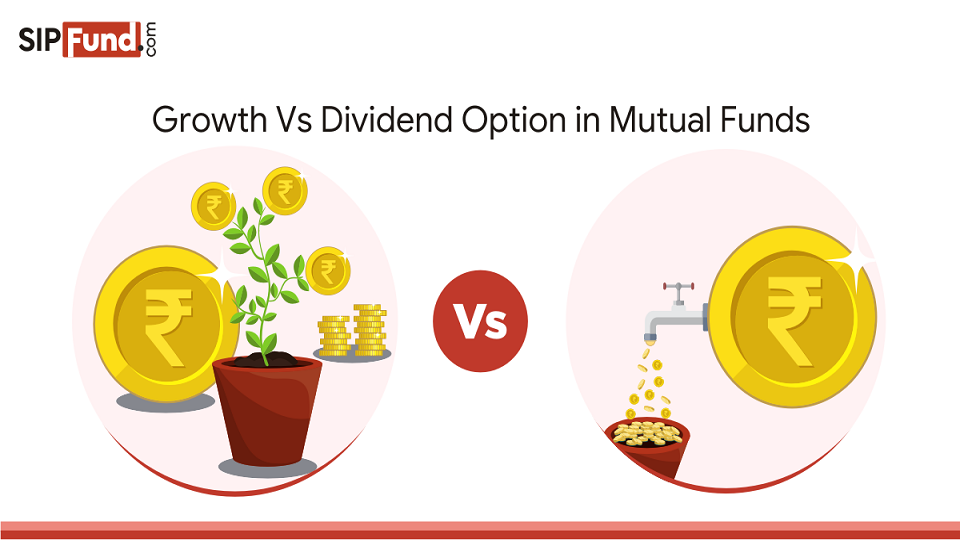
Growth Vs Dividend Option in Mutual Funds
For every mutual fund scheme, mutual fund houses offer two broad types of options - Growth and dividend. There is always a debate that the growth option is better, or the dividend option is better. It is advised that you select the option that is more suited to your investment needs – financial objective and tax situation. Let us now discuss the difference between growth and dividend options and how they work.
Growth option
The profits booked by the investor in this scheme are getting reinvested back into the scheme. As a result of reinvestment of profits, net asset value (NAV) rises. It has been observed that as the scheme gains profit over time, NAV rises and in case of loses it falls. Investors can realize profits either be selling or redeeming the units. Growth options gives returns in the form of rising values of mutual fund units.
For example, suppose you buy 1000 units of an equity fund at a NAV of ₹ 30. When NAV rises to ₹ 40 in one year. Investors can sell the units and receive a sum of ₹ 40,000. Hence, profits from growth options would be ₹ 10,000 (₹ 40,000- ₹ 30,000).
Given below are some of the key points to understand about growth option:
Dividend option
Under dividend option scheme, profits made by the investments will not be reinvested by the mutual funds. They are distributed as profits or dividends to investors on daily, monthly, quarterly or annual basis. Distribution of dividends under mutual fund is completely at the discretion of fund manager.
Dividend scheme of mutual funds comes in different forms such as dividend payouts and dividend reinvestment
Dividend payout plan
Under dividend payout plan investors get the dividend directly into their bank account.
Dividend reinvestment plan
Funds reinvests the dividend back into the same fund that has declared the dividend.
Given below are some of the key points to understand about dividend option:
Taxation
In growth option, taxation is applied only at the time of redemption. Equity mutual funds that are held for less than 12 months, Short Term Capital Gains (STGC) are taxed at 15%. If the holding period is more than 12 months, Long Term Capital Gains (LTCG) of up to ₹ 1 Lakh are tax exempt for the financial year and thereafter, taxed at 10%. In debt mutual funds, STCG (held for less than 36 months) are taxed as per the investor’s income tax slab and the LTCG (held for more than 36 months) are taxed at 20% after allowing indexation benefits.
In dividend option, dividends paid by both the equity and debt mutual funds are taxed in the hands of the investors as per their applicable tax slab. As per Income Tax Act, if the investor is a Resident Individual and the dividend distributed or likely to be distributed the investor during the financial year exceeds ₹ 5,000 TDS @ 10% from dividend income is applicable. In case the investor does not have PAN, TDS rate of 20% is applied.
Mutual funds dividend versus Stock dividends
Mutual Fund and stock dividends are not same. Stock dividends are distributed to shareholders when company makes profits whereas mutual fund dividends may or may not be an indicator of the profitability of a mutual fund scheme. When investors get high mutual fund dividends then that does not necessarily mean that the fund is performing well and vice versa.
Growth or Dividend - which one is better?
Growth and dividend options give almost same return. However, in case of dividend payout scheme, investors do not get the benefits of compounding returns as the dividend received is not re-invested. On the contrary, the growth option gives the benefit of compounding to the investors by reinvesting the profits which results in higher returns when scheme matures. Investors who want to multiply their wealth in longer period can choose growth options. Investors who have a specific financial goal to fulfill should also choose growth options. Investors who want regular income flow are suggested to invest in the dividend options.
Conclusion
There is not one best fit all mutual fund policy as investors have different financial goals given their income levels. Speaking of dividend mutual fund scheme, investor should understand that it will not indicate the profitability of fund and dividends are not fixed. Investors whose sustainability do not depend on dividends can choose growth mutual fund scheme. There is hardly any wealth creation under dividend options. On the contrary investors who can stay for longer duration and want to take the benefit of compounding by reinvesting back into the scheme can choose growth options. While investing in either dividends or growth options, investors should do a thorough research and see which one is best aligned with their financial goals.

